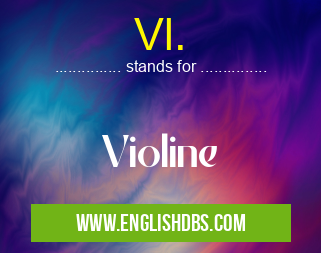What does VL. mean in GERMAN
Vl. is an abbreviation for the word Violine. A violine, commonly known as a "fiddle", is a stringed musical instrument developed in Italy during the 1500s. It has four strings tuned to the notes of G-D-A and E and is held under the chin while played with a bow. This instrument has been used in many genres of music such as classical, jazz, folk, bluegrass, country, and rock music. The unique sound produced by a violine makes it an invaluable addition to any musician's toolkit

Vl. meaning in German in International
Vl. mostly used in an acronym German in Category International that means Violine
Shorthand: Vl.,
Full Form: Violine
For more information of "Violine", see the section below.
» International » German
Essential Questions and Answers on Violine in "INTERNATIONAL»GERMAN"
How do I play the violin?
Playing the violin requires some practice and dedication, however there are a few basic steps you can follow. To start, make sure your posture is correct, with your left foot slightly ahead of your right. Your chin should rest on the chin rest and your shoulder soft and relaxed. Hold the neck with your left hand and place your fingers on the strings with a loose grip. Use your bow to press against the strings while moving it back and forth. If you need further guidance or assistance, many music teachers offer private lessons for playing the violin.
What type of bow should I use for my violin?
The type of bow that is best suited for you depends on what kind of music you want to play and what level of experience you have with string instruments. Generally speaking, an all-purpose beginner bow is a good starting point if you're just beginning to learn the violin. If you plan on playing more advanced pieces of music or will be performing in orchestras or ensembles, then investing in a higher quality bow is recommended.
What maintenance do I need to do on my Violin?
It's important to keep your violin clean in order to ensure its longevity and sound quality. After each use, give it a wipe down with either a clean cloth or microfiber cloth. You may also want to periodically check for any changes in tension by turning tuning pegs after each use as well as re-tighten if needed. You should also have it looked over by a professional luthier every few years in order to detect any hidden damage that cannot be seen by yourself.
Can I buy an affordable violin?
Yes! There are many different types of violins available at various price points depending on quality level and material used. For someone just starting out playing the violin who wants something more affordable there are options available such as fractional sized instruments (smaller versions of full-sized violins) or student-grade models which feature solid woods such as maple or spruce but usually cost less than their professional counterparts.
How often should I replace my rosin?
Rosin should be replaced when it becomes too hard to apply easily onto the bow hair or when it starts losing its ability to produce sound from the strings of the instrument due to lack of friction/adhesion between them.
Do violins come tuned?
Yes! All new violins will come pre-tuned using standard tuning techniques so that they are ready for use right away – no additional adjustments necessary! However, if any adjustments have been made over time due to wear and tear from being played consistently, then these must be carried out before playing again.
At what age can children begin learning how to play violin?
Depending on your child’s natural aptitude towards learning new skills like memorizing notes & finger positions as well as forming motor responses & muscle memory – most children typically begin learning how to play around 6 years old although younger ages can start with certain basics first such as bowing & holding technique before more advanced concepts like complex rhythm patterns etcetera.
Does size matter for selecting a Violin?
Yes - Size does matter since different sizes offer different levels of comfortability depending on your size & body measurements – Selecting an appropriately sized instrument allows players better mobility & access when reaching higher notes while maintaining proper posture & technique during performances
